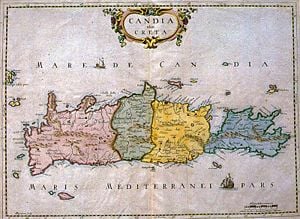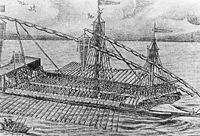Cretan War (1645–1669)
The Cretan War, or War of Candia, as the sixth Turkish–Venetian War is better known, was a conflict between the Republic of Venice and her allies (the Knights of Malta, the Papal States, French volunteers, and pirates from Mani) against the Ottoman Empire and the Barbary States, fought over the Venetian possession of Crete. The war lasted from 1645 to 1669, and was fought in Dalmatia, Crete, and in numerous naval engagements in the Aegean Sea. The prolonged Siege of Candia (modern Heraklion), the capital of Crete, was the central event of the war, and its eventual fall in 1669 sealed the fate of the island, ending the war in an Ottoman victory.
Four and a half centuries of Venetian rule in Crete thus came to an end. Crete remained part of the Ottoman Empire until 1912, when it became part of Greece. A later attempt to re-take Crete was unsuccessful. Ironically, Venice at times used Crete to circumvent Papal bans on trade with the Muslim world, which even in the middle of the Crusades was always the mainstay of Venetian trade. On the one hand, this war can be seen as part of the ongoing civilizational and religious rivalry between the European and Ottoman spaces. On the other hand, Venice's relations with the Muslim world were complex and Venice did not tend to regard Muslims with the same degree of animosity as did other Europeans and was in many respects responsible for the development of a more positive view of Islam. Works of Muslim learning in philosophy, medicine and other disciples were published in Venice from the fifteenth century. Venice could not avoid being caught up in conflict and competition with the Ottoman empire yet always preferred trade to war. Venice never ceased to have diplomatic and commercial relations with Istanbul.
Background
After the loss of Cyprus to the Ottomans in the fifth Turkish–Venetian War (1570–1573), the island of Crete was the last major overseas possession of Venice. Its important strategic position made it an obvious target for Ottoman expansion, and the Serenissima, with its weak military and great dependence on uninterrupted trade, was anxious not to provoke the Ottomans. Venice scrupulously observed the terms of its treaty with the Ottomans, securing over sixty years of peaceful relations. Thus, in 1638, when a Venetian fleet attacked a fleet of Barbary pirates that had sought protection in the Ottoman port of Valona, the situation was defused, with the Republic paying the Ottomans an indemnity.[1]
A similar episode, however, that occurred in 1644, had an entirely different outcome: on September 28, the Knights of Malta attacked an Ottoman convoy on its way from Constantinople to Alexandria, aboard which were a number of pilgrims bound for Mecca, including the exiled Kızlar Ağa (Chief Black Eunuch) Sünbül Ağa, the kadi (head Muslim jurist) of Cairo and the nurse of the future Sultan Mehmed IV. During the fight, Sünbül Ağa and most of the important pilgrims were slain, while 350 men and 30 women were taken to be sold as slaves.[2] The Knights loaded their loot on a ship, which docked at a small harbor on the southern coast of Candia for a few days, and disembarked a number of sailors and slaves.[3] The Ottomans were enraged at the incident, and the Porte accused the Venetians of deliberate collusion with the Knights, which the Venetians vehemently denied. With the hawkish party being then dominant in the Ottoman court,[4] the incident was seen as a perfect pretext for war with Venice.[5] Despite a long period of negotiations, which lasted until well into 1645, and against the objections of the Grand Vizier Sultanzade Mehmed Pasha,[6] war was decided upon. An expedition was quickly assembled with over 50,000 troops and (reputedly) 416 vessels, under Kapudan Pasha Silahdar Yusuf Pasha, the Sultan's son-in-law. The Ottoman armada sailed from the Dardanelles on 30 April, heading towards the harbor of Navarino in the Peloponnese, where it remained for three weeks.[7] The target for the fleet was not announced, but the Ottomans implied it would be Malta.[5]
The war
Early operations in Crete
The Venetians were fooled by the Ottoman subterfuge and were taken by surprise at the arrival of the Ottoman fleet at Crete on June 26, 1645. Despite the efforts of the recently appointed provedditore, Andrea Corner, the Venetian defenses were still in a bad state.[8] The fortifications especially had been long neglected and much effort was put into repairing them. Crete was reinforced in late 1644, with 2,500 troops and provisions, and the Republic began arming its fleet, while assistance was promised in the event of war by the Pope and Tuscany.[9] However, the local Greek population was not well-disposed towards the Venetians,[10] something that would prove to be of critical importance, not only were the Ottomans thus able to quickly establish control over the countryside, but in later years, when the Ottomans in the island were practically cut off from seaborne supplies, only the local produce, provided by the Greek population, sustained them.[5]
The Ottomans first attacked the small island fortress of St. Todero, the commander of which, the Istrian Blasio Zulian, blew himself, the fortress and its garrison up rather than let it fall to the Ottomans. The Ottoman army next advanced to the city of Canea (Chania), which fell on August 17, after a siege that lasted for 56 days.[11] At the same time, however, the Venetians were strengthened, as the promised help started to arrive in the form of galleys from the Papal States, Tuscany, Malta, and Naples. In September, the Ottoman fleet was in disarray, but the allied Christian fleet, under the cautious command of Niccolò Ludovisi, the Pope's nephew, failed to exploit the opportunity for a decisive strike. When the Christian forces tried to retake Canea on October 1, with a fleet of over 100 ships, the stout Turkish defense and the Allies' lack of cooperation doomed the attack.[11]
In November, Silahdar Yusuf Pasha left behind a strong garrison and returned to Constantinople for the winter. There however, he fell foul of the Sultan and was executed.[10] Nevertheless, Ottoman preparations continued with a view to renewing and expanding the war, while the Venetians were frantically trying to raise money and men, and attempting to induce other European powers to join them against the Ottomans. In an Europe locked into the fierce antagonisms of the Thirty Years' War, their pleas fell mostly on deaf ears.[12]
The following year, the Ottomans made good progress, helped by the arrival of reinforcements and supplies in June (see below). An attack by the Venetian admiral Giovanni Cappello on the Turkish fleet at Chania Bay in August failed, as did his attempt to break the Ottoman blockade of Rettimo (Rethymno). As a result, the city fell on October 20, while the citadel held out until November 13.[13] During the winter of 1646/1647, both sides suffered from an outbreak of plague; throughout the spring of 1647, operations did not make much headway. In mid-June however, a small Ottomans routed a larger body of Venetian mercenaries. This Ottoman success paved the way for Hussein Pasha, the local commander in chief (serdar), to conquer the eastern half of the island, with the exception of the fortress of Siteia.[14] The Venetians suffered some grievous losses, and by 1648, all of Crete, with the exception of Candia and a few strongholds like Grambusa, was in Ottoman hands.[10]
The Siege of Candia begins
The siege began in May 1648, and the Turks spent three months investing the city, which included cutting off the water supply. Eventually, the it would last until 1669, the second longest siege in history after the siege of Ceuta by the Moors (1674-1700). The Ottoman besiegers were adversely affected by the bad supply situation which the activity of the Christian fleets in the Aegean had caused. In addition, the overall Ottoman war effort was severely hampered by increased domestic instability and the diversion of resources to other fronts. The lack of supplies and reinforcements, and the horrible conditions of the siege trenches caused occasional outbursts of mutiny among the war-weary troops, like in August 1649, when the Janissaries demanded to be sent back.[15] The siege continued without much prospect on either side, until the arrival of a new Ottoman expeditionary force in 1666.
- For a complete list of naval engagements, see Naval battles of the Cretan War
Venice could not directly confront the large Ottoman expeditionary force on Crete, but it did possess a fine navy, that could intervene and cut the Ottoman supply routes.[16] In 1645, the Venetians and their allies possessed a fleet of 60–70 galleys, 4 galleasses and about 36 galleons.[17] In addition, the Venetians hired armed merchantmen from the Netherlands, and later also from England, to augment their forces. Their first operation was an attempt to blockade the Dardanelles in 1646. A force of 23 ships under Tommaso Morosini scoured the Aegean of Ottoman shipping, and attempted to capture the strategically important island of Tenedos at the entrance of the Dardanelles. The kapudan pasha Kara Musa led a fleet of 80 warships against the Venetians, but his fleet was driven back into the Dardanelles on May 26.[18] However, the blockading fleet was unable to stop the next exit of the Ottoman fleet on June 4, when the lack of wind enabled the Ottoman galleys to evade the Venetian sailing ships. The Ottomans were thus able to land new troops and supplies on Crete unopposed.[19] The efforts of the Venetian fleet to counter the Ottoman land operations in Crete likewise failed, through a combination of timidity on behalf of their commanders, the delays in payment for the crews, and the effects of a widespread plague.[20]
On January 27, 1647, the Venetians lost Tommaso Morosini, when his ship was forced to face the entire Ottoman fleet of 45 galleys. In the ensuing fight, Morosini was killed, but managed to cause significant casualties to the Ottomans, including Kara Musa Pasha himself. The ship itself was rescued by the timely arrival of the Venetian fleet under the captain general Giovanni Battista Grimani. This stand-off, where a single ship had caused such damage to the entire Ottoman fleet, was a major blow to Ottoman morale.[21] Despite some successes like a raid in Chesme, the remainder of the year was a failure for the Venetians, as several attempts to blockade Turkish harbors failed to stem the flow of supplies and reinforcements to Crete.[22]
The Venetians returned to the Dardanelles in 1648 and succeeded in blockading the Straits for a whole year. The Ottomans countered this in part by building a new fleet at Çeşme, and in 1649, a strengthened Ottoman fleet broke the blockade.[23] This highlighted the weakness of the Venetian position: maintaining long blockades with galleys was an inherently difficult task, and the Republic did not have enough ships to control both the Dardanelles and the passage of Chios at the same time.[16]
On July 10, 1651, the first significant naval battle of the war was fought south of Naxos, a three-day engagement in which the Venetians under Lazzaro Mocenigo were victorious. A series of four battles was fought off the Dardanelles in 1654–55, without achieving any decisive results, although by and large the Venetians, under Mocenigo's successor Lorenzo Marcello, held the upper hand over Kapudan Pasha Kara Murad.[10] In June 1656, however, a combined Venetian–Maltese fleet inflicted on the Ottomans, under Kenan Pasha, their "worst naval defeat since Lepanto."[24] This victory enabled the Venetians to seize Tenedos on July 8 and Lemnos on August 20, effectively cutting off the resupply of Crete and causing a shortage of food in Constantinople.[25]
In 1657, the Ottomans reversed the situation. A new and energetic Grand Vizier, Köprülü Mehmed Pasha, had been appointed, who reinvigorated the Ottoman war effort. Several naval actions occurred between the Ottomans and the Venetians, and despite achieving some victories, most notably the three-day action of July 17–20, 1657, the overstretched Venetians were forced to abandon Lemnos and Tenedos.[26] In 1658, Ottoman power was redirected north in a campaign against George II Rákóczi, Prince of Transylvania, which evolved into a long drawn-out conflict with the Habsburgs. In the meantime, war-weariness had set in among the Venetians, who suffered from the disruption in trade. Peace feelers were sent to the Ottomans, but their demand for the full concession of Crete as a condition for peace was unacceptable to the Republic.[26]
With the end of the war between France and Spain however, the Venetians became encouraged, hoping to receive increased assistance in money and men, especially from France. In the event, the promised help was slow to materialize. In 1659, the Venetian commander on Crete, Francesco Morosini, attempted to go into the offensive by landing in the Morea and joining forces with the Maniots, who had risen up against the Ottomans. The allies took Kalamata, but Morosini was eventually forced to return to Candia, abandoning this venture. The Venetian naval victories at Milos in 1661, and at Kos in 1662 were not able to break the stalemate, and a Venetian effort, in 1666, to retake Chania failed. Finally, with the signing of the Peace of Vasvár in 1664, the Ottomans were able to focus their strength against Crete: Grand Vizier Köprülü Fazıl Ahmed initiated large preparations in the winter of 1665/66. An Ottoman peace proposal, which would have allowed Venice to keep Candia against an annual payment of tribute was rejected,[27] and in May 1666, the Ottoman army departed from Thrace for southern Greece, form where it would embark for Crete.
The siege of Candia ends
The Ottoman army arrived on the island during the winter of 1666/1667, and in May, the final phase of the siege, overseen by the Grand Vizier himself, began. It would last for 28 months and cost the lives of 70,000 Turks, 38,000 Cretans and slaves and 29,088 of the city's Christian defenders.[17] The Venetians were reinforced with a 5,000-strong French contingent and attempted to lift the siege in July 1669, but, after a month and a half of fighting, they failed.[28] With the departure of the French force in August and the city literally in ruins, Morosini was forced, after a council of war on August 27, but without first consulting Venice, to capitulate. On September 27, 1669, the city was surrendered to the Ottomans, while the survivors of the garrison, the citizens and their treasures were evacuated.[28]
The war in Dalmatia
The Dalmatian front was a separate theater of operations, which was involved in the early phase of the war. The conditions there were almost reverse to those in Crete: For the Ottomans, it was too far away and relatively insignificant, while the Venetians operated near their own bases of supply and had undisputed control of the sea, being thus able to easily reinforce their coastal strongholds. The Ottomans launched a large-scale attack in 1646, made some significant gains, including the capture of the "impregnable" fortress of Novigrad on July 4.[29] In the next year, the tide turned, as the Venetian commander Leonardo Foscolo seized several forts and retook Novigrad,[30], while a month-long siege of the fortress of Sebenico by the Ottomans in August and September failed.[31]
In the next year, however, the Venetians re-captured most of the lost ground, including Clissa.[23]
Peace treaty and aftermath
The surrender of Candia ended the four and a half centuries of Venetian rule in Crete. On his own initiative, Morosini concluded a permanent peace agreement with the Ottomans. Under the circumstances, it was relatively lenient: Venice would retain the island of Tinos and the isolated island fortresses of Spinalonga, Grambusa, and Souda off the Cretan coast, as well as the gains made in Dalmatia.[28] Nevertheless, Venice had lost its greatest and most prosperous colony, and the small gains it made in Dalmatia were insufficient compensation. Upon his return to Venice in 1670, Morosini was tried on charges of insubordination and treason, but was acquitted. Fifteen years later, he would lead the Venetian forces in the Morean War, where the Republic attempted, for the last time, to reverse its losses and reestablish itself as one of the major powers of the Eastern Mediterranean.[17] During that war, in 1692, a Venetian fleet attempted to retake Candia, but failed. Crete would remain in Ottoman hands until 1912, when, during the First Balkan War, it was united to Greece.
See also
Notes
- ↑ Finkel (2006), 222.
- ↑ Setton (1991), 111.
- ↑ Finkel. 2006. page 225.
- ↑ Finkel (2006), 226.
- ↑ 5.0 5.1 5.2 Finlay (1856), 128.
- ↑ Setton (1991), 124.
- ↑ Setton (1991), 126.
- ↑ Setton (1991), 120.
- ↑ Setton (1991), 121.
- ↑ 10.0 10.1 10.2 10.3 Finkel (2006), 227.
- ↑ 11.0 11.1 Setton. 1991. page 127.
- ↑ Setton (1991), 131.
- ↑ Setton (1991), 141.
- ↑ Setton (1991), 147.
- ↑ Finkel (2006), 247.
- ↑ 16.0 16.1 Turnbull. 2003. page 85.
- ↑ 17.0 17.1 17.2 VENIVA consortium, The War for Candia. Retrieved August 24, 2008.
- ↑ Setton (1991), 139.
- ↑ Setton (1991), 139-140.
- ↑ Setton (1991), 140-141.
- ↑ Setton (1991), 146.
- ↑ Setton (1991), 147-148.
- ↑ 23.0 23.1 Finkel (2006), 227.
- ↑ Finkel (2006), 248.
- ↑ Finkel (2006), 251-252.
- ↑ 26.0 26.1 Finkel (2006), 256.
- ↑ Finkel (2006), 270.
- ↑ 28.0 28.1 28.2 Finkel (2006), 271.
- ↑ Setton (1991), 142.
- ↑ Setton (1991), 148.
- ↑ Setton (1991), 149.
ReferencesISBN links support NWE through referral fees
- Finlay, George. The History of Greece under Othoman and Venetian Domination. London: William Blackwood and Sons, 1856.
- Finkel, Caroline. Osman's Dream: The Story of the Ottoman Empire 1300-1923. London: John Murray, 2006. ISBN 978-0719561122
- Norwich, John Julius. A History of Venice. London: Penguin, 1988. ISBN 0140066233
- Setton, Kenneth Meyer. Venice, Austria, and the Turks in the Seventeenth Century. Darby, PA: DIANE Publishing, 1991. ISBN 0871691922
- Turnbull, Stephen. The Ottoman Empire 1326-1699. New York: Rutledge, 2003. ISBN 978-0415969130
Credits
New World Encyclopedia writers and editors rewrote and completed the Wikipedia article in accordance with New World Encyclopedia standards. This article abides by terms of the Creative Commons CC-by-sa 3.0 License (CC-by-sa), which may be used and disseminated with proper attribution. Credit is due under the terms of this license that can reference both the New World Encyclopedia contributors and the selfless volunteer contributors of the Wikimedia Foundation. To cite this article click here for a list of acceptable citing formats.The history of earlier contributions by wikipedians is accessible to researchers here:
The history of this article since it was imported to New World Encyclopedia:
Note: Some restrictions may apply to use of individual images which are separately licensed.



